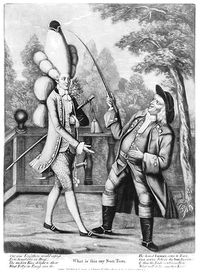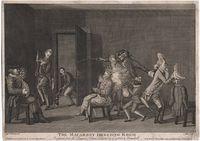Annotation:Macaroni (The): Difference between revisions
No edit summary |
m (Text replacement - "garamond, serif" to "sans-serif") |
||
| Line 1: | Line 1: | ||
=='''Back to [[{{BASEPAGENAME}}]]'''== | =='''Back to [[{{BASEPAGENAME}}]]'''== | ||
---- | ---- | ||
<p><font face=" | <p><font face="sans-serif" size="4"> | ||
'''MACARONI.''' English, Country Dance Tune (2/4 time). D Major. Standard tuning (fiddle). AABB. 'Macaroni' was 18th century slang for a dandified young gentleman; a preening aristocrat (the only class that could afford fashion). [[File:macaroni2.jpg|200px|thumb|right|Father and son]] | '''MACARONI.''' English, Country Dance Tune (2/4 time). D Major. Standard tuning (fiddle). AABB. 'Macaroni' was 18th century slang for a dandified young gentleman; a preening aristocrat (the only class that could afford fashion). [[File:macaroni2.jpg|200px|thumb|right|Father and son]] | ||
Macaroni fashions were imported from Italy and France, as the name suggests, and Macaroni wigs became an extreme fashion in the 1770's. Macaroni's not only dressed in a foppish manner, they adopted feminine mannerisms, and the men were deemed 'effeminate.' | Macaroni fashions were imported from Italy and France, as the name suggests, and Macaroni wigs became an extreme fashion in the 1770's. Macaroni's not only dressed in a foppish manner, they adopted feminine mannerisms, and the men were deemed 'effeminate.' | ||
| Line 11: | Line 11: | ||
<br> | <br> | ||
</font></p> | </font></p> | ||
<p><font face=" | <p><font face="sans-serif" size="4"> | ||
''Source for notated version'': | ''Source for notated version'': | ||
<br> | <br> | ||
<br> | <br> | ||
</font></p> | </font></p> | ||
<p><font face=" | <p><font face="sans-serif" size="4"> | ||
''Printed sources'': Straight & Skillern ('''Two Hundred and Four Favourite Country Dances, vol. 1'''), c. 1775; No. 58, p. 29. Thompson ('''Compleat Collection of 200 Favourite Country Dances, vol. 3'''), 1773; No. 8. | ''Printed sources'': Straight & Skillern ('''Two Hundred and Four Favourite Country Dances, vol. 1'''), c. 1775; No. 58, p. 29. Thompson ('''Compleat Collection of 200 Favourite Country Dances, vol. 3'''), 1773; No. 8. | ||
<br> | <br> | ||
<br> | <br> | ||
</font></p> | </font></p> | ||
<p><font face=" | <p><font face="sans-serif" size="4"> | ||
''Recorded sources'': <font color=teal>The earliest sound recording of the tune is on the 2nd Barrel, 2nd tune, of a mechanical Chamber Barrel Organ [http://www.firedragon.com/~kap/Langshaw/], hand-built by John Langshaw (1718-1798), Organ Maker, Lancaster, c. 1785. The organ is one of three surviving Langshaw organs. </font> | ''Recorded sources'': <font color=teal>The earliest sound recording of the tune is on the 2nd Barrel, 2nd tune, of a mechanical Chamber Barrel Organ [http://www.firedragon.com/~kap/Langshaw/], hand-built by John Langshaw (1718-1798), Organ Maker, Lancaster, c. 1785. The organ is one of three surviving Langshaw organs. </font> | ||
</font></p> | </font></p> | ||
Revision as of 15:18, 6 May 2019
Back to Macaroni (The)
MACARONI. English, Country Dance Tune (2/4 time). D Major. Standard tuning (fiddle). AABB. 'Macaroni' was 18th century slang for a dandified young gentleman; a preening aristocrat (the only class that could afford fashion).

Macaroni fashions were imported from Italy and France, as the name suggests, and Macaroni wigs became an extreme fashion in the 1770's. Macaroni's not only dressed in a foppish manner, they adopted feminine mannerisms, and the men were deemed 'effeminate.'
The melody also appears in Straight & Skillern's Two Hundred and Four Favourite Country Dances, vol. 1 (London, 1775) and Longman, Lukey and Broderip's Bride's Favourite Collection of 200 Select Country Dances, Cotillions (London, 1776).

Source for notated version:
Printed sources: Straight & Skillern (Two Hundred and Four Favourite Country Dances, vol. 1), c. 1775; No. 58, p. 29. Thompson (Compleat Collection of 200 Favourite Country Dances, vol. 3), 1773; No. 8.
Recorded sources: The earliest sound recording of the tune is on the 2nd Barrel, 2nd tune, of a mechanical Chamber Barrel Organ [1], hand-built by John Langshaw (1718-1798), Organ Maker, Lancaster, c. 1785. The organ is one of three surviving Langshaw organs.
